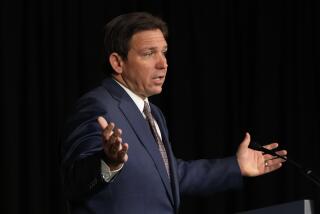Column: Dear news media, Fla. Gov. DeSantis’ COVID record isn’t a success, but a failure

- Share via
Florida’s Republican governor, Ron DeSantis, must have magic at his fingertips.
We’re not talking about his purported skill at fighting the COVID-19 pandemic. We’re talking about his ability to snow the press into taking at face value the claim that his refusal to impose stringent anti-virus rules and regulations has been an unalloyed success.
The latest publication to fall into line is Politico, which on Thursday posted an article headlined, “How Ron DeSantis won the pandemic.” A companion piece observed that he has “survived the pandemic,” and that “Florida has fared no worse, and in some ways better, than many other states — including its big-state peers.”
We’ve succeeded, and I think that people just don’t want to recognize it because it challenges their narrative.
— Florida Gov. Ron DeSantis, last May
Leaving aside that this sort of coverage treats the coronavirus battle as if it’s a sporting contest deserving of up-to-the-minute color commentary, the best that could be said about these judgments is that they’re premature.
The struggle against the pandemic is still going on — in Florida and globally — so why the rush to declare DeSantis the “winner” of a war that could yet be lost?
Politico isn’t alone in anointing DeSantis the victor. So too has the Associated Press, which on March 13 posted an article stating, inadequately, that “despite their differing approaches, California and Florida have experienced almost identical outcomes in COVID-19 case rates.”
CNN came to a similar conclusion. “DeSantis’ gamble to take a laissez faire approach appears to be paying off,” it reported — though it was careful enough to qualify that its judgment applied “at least politically, at least for now.”
Get the latest from Michael Hiltzik
Commentary on economics and more from a Pulitzer Prize winner.
You may occasionally receive promotional content from the Los Angeles Times.
Indeed, DeSantis’ record on COVID-19 is attracting attention strictly because of politics. He’s being touted as a leading candidate for the GOP presidential nomination in 2024, as silly as it is to speculate today on such a distant a horse race. DeSantis’ COVID record is presented as Exhibit 1 for his front-runner status.
Yet it’s important to recognize that a state’s success or failure in combating COVID-19 depends on a multitude of factors, many of which are outside a governor’s control. Those who claim credit for good-looking statistics may be setting themselves up for a boatload of blame if the numbers turn ugly.
As we’ve remarked before, one thing that sets DeSantis apart from most other governors, red or blue, is his tendency to present himself as the victim of anti-conservative coverage.
He grouses unceasingly about being overlooked by the unsympathetic news media: “We’ve succeeded,” he said truculently last May 20, “and I think that people just don’t want to recognize it because it challenges their narrative.”
Florida Gov. DeSantis represents all that’s wrong with America’s coronavirus response.
Assertions about DeSantis’ success rest on several pillars. One is the claim that Florida hasn’t done quite as badly as experts predicted last year, when DeSantis refused to shut down his state and enforce social hygiene measures such as mask wearing. Another is that the differences in outcomes between Florida and other states, particularly in COVID-related deaths, are supposedly minimal.
The judgment also depends on treating every state as a homogeneous entity, eliding variations of urban vs. rural, rich neighborhoods vs. poor, Black vs. white, and so on. And on treating every state as a hermetically sealed fortress unto itself, as though policies in one state have no impact beyond its borders.
All those factors demand close scrutiny. Since that seldom happens, it falls to us to dive into the details. We’ll match Florida’s experience against California’s, since California is among the more frequent punching bags for DeSantis and his fan base.
Let’s take it from the top. It’s arguably true that Florida’s record on the pandemic hasn’t been as bad as was forecast. That’s not the same as saying it’s good. Florida’s COVID death rate is about 155 per 100,000 population, according to data from Johns Hopkins University reported by the Washington Post. California’s is about 141.
The difference isn’t trivial. As my colleagues Soumya Karlamangla and Rong-Gong Lin II observed earlier this month, “If California had Florida’s death rate, roughly 6,000 more Californians would be dead from COVID-19 .... And if Florida had California’s death rate, roughly 3,000 fewer Floridians would be dead from COVID-19.”
As of Friday, Johns Hopkins counts 33,219 COVID deaths in Florida, which has a population of about 21.5 million, compared with 55,795 in California, which has a population of about 40 million. Those figures are a reproach to anyone who tries to assert that the war on COVID-19 has been “won,” in either state.
Yet statewide statistics tell a partial story at best. It’s especially misleading to apply a broad brush to California, one of the most geographically and demographically diverse states in the union. So let’s break the numbers down by county.
By far the worst death rate among large California counties is Los Angeles, at a total of 224.5 deaths per 100,000 residents through the pandemic thus far. As Karlamangla and Lin have explained, L.A. County was uniquely vulnerable to the pandemic, given its high levels of poverty and homelessness and its preponderance of densely packed neighborhoods and multigenerational housing.
L.A. also has a large population of immigrants, many of whom may have been discouraged from seeking COVID testing or treatment during 2020 by the Trump administration’s “public charge” policy, which threatened immigrants with deportation if they sought public services.
The county also has a large population of essential workers — those with little choice but to travel outside their homes to work, heightening their potential for exposure and for passing infection to others.
The coronavirus has outsmarted governors who opened their states too early -- almost all of them.
At the other end of the scale from Los Angeles, however, is San Francisco, which has one of the lowest COVID death rates among major metropolitan areas in the country — 51.4 per 100,000 population.
The Bay Area’s record testifies to the efficacy of stringent anti-pandemic measures: Its counties locked down early and firmly, observe mask wearing and social distancing rules fairly well, and have been cautious about reopening.
No major county in Florida has a death rate anywhere as low as San Francisco’s. The lowest rate is that of Monroe County (the Florida Keys) at 65 per 100,000 population. County authorities shut down tourist businesses on the Keys at the end of March, even erecting roadblocks on U.S. 1, the only highway into or out of the Keys, to prevent non-residents from coming in; the roadblocks came down June 1 but a stringent mask requirement remains in effect in Key West.
The death rates in most of Florida’s major population centers resemble that of Los Angeles: Miami-Dade, the largest, has a rate of 210 deaths per 100,000, Palm Beach 173, Pinellas County (St. Petersburg) 156.
In granular terms, in other words, Florida hasn’t done better than California. Both states are mosaics of rules and regulations, and in both states local conditions and local measures trump those of state governments.
Miami and the Tampa Bay metroplex both have tried to encourage mask wearing and social distancing because their leaders recognize that they face different conditions from rural and less dense regions that have followed DeSantis’ policies; California also has placed pandemic policies in the hands of county officials, with uneven effects.
Florida hasn’t done better than California despite different policies — in the parts of each state that resemble each other demographically, the challenge is similar, and so is the weaponry. And when you put it all together, Florida still does worse overall than California.
Some of DeSantis’ defenders argue that Florida has done better than should have been expected, given that its population is among the oldest, on average, in the country and therefore its residents are especially susceptible to COVID-19.
This is a curious argument, since DeSantis and his sycophants have asserted that the key to his success in combating the pandemic has been taking special care of his state’s seniors. But he can’t have things both ways—either the state’s record has suffered because of its demographics, or he has triumphed over the demographics. Which is it?
One issue that gets consistently glossed over in reporting on DeSantis’ “win” is the degree to which Florida may be exporting its pandemic problem. The state’s beaches and coastal entertainment zones were wide open during last year’s college spring break, and are again this year.
DeSantis loves to boast about the tourism boom in South Florida, but his braggadocio should be a warning for other states. That’s because there are signs that the spring break carousers simply brought their infections and their consequences home with them last year.
America has fallen so far behind in the coronavirus fight that it might lose the war permanently.
Researchers at the Federal Reserve Bank of New York and Ball State University found that COVID case rates in counties with universities that scheduled breaks early in the spring last year rose within a week of students returning to campus, compared to rates in counties with few college students. Mortality rates began to rise in those locations three to five weeks after students returned, suggesting that students transmitted their infections to higher-risk (that is, older) people.
They also found that universities with students more likely to travel by air, to New York City and to Florida “contribute[d] more to COVID-19 spread than ... universities with less of this travel.”
To put it another way, Florida may welcome spring tourists with open arms, knowing they’ll be someone else’s problem when they become sick and spread their illness far and wide. The virus knows no geographic boundaries, and it’s perfectly content to hitch a ride.
Finally, what about Florida’s economic “boom”? Here’s DeSantis, in full gloat, courtesy of CNN: “If you look at what’s happening in South Florida right now, I mean this place is booming. It would not be booming if it was shut down. Los Angeles isn’t booming. New York City’s not booming. It’s booming here because you can live like a human being.”
The breadth of this boom is open to question. The news articles painting DeSantis as a political winner often feature quotes from contented business owners, but they tend to be bar and restaurant owners and other petty merchants happy that their establishments have remained open.
Politico observed that California’s Disneyland has remained closed while Orlando’s Walt Disney World is open, but fails to mention that Disney World imposes strict social hygiene measures, including mask wearing and social distancing that aren’t part of the DeSantis playbook.
Economic booms are relative. Compared to California, Florida’s economy is a popgun. Its per capita gross domestic product is about $51,200; California’s is $77,500. Florida’s median household income was about $59,200 in 2019; California’s was about $80,440.
Of more pressing significance, Florida’s state budget faced a shortfall of more than $2 billion (at least before Congress enacted a pandemic relief bill with billions of dollars in help for states”). California has recorded a windfall of some $15.5 billion.
The discrepancy isn’t due to differences in civic virtue, but to the states’ divergent tax structures. Florida has no income tax, but California depends heavily on its income tax, which is sensitive to the sort of investment gains seen during 2020. California’s windfall isn’t expected to last beyond this year.
The media’s rush to crown Ron DeSantis as having vanquished COVID-19 looks more like a rush to get in front of a parade every day. But it’s a mug’s game. A lot can happen between now and the next presidential election, and as we’ve seen, the coronavirus is ready and willing to prove everybody wrong.
More to Read
Get the latest from Michael Hiltzik
Commentary on economics and more from a Pulitzer Prize winner.
You may occasionally receive promotional content from the Los Angeles Times.














